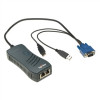Lantronix Spider KVM Over IP Switch Quick Start Guide - Page 2
Target Computer Setup, Power Control Unit Pcu, Spider Duo Web Configuration
 |
View all Lantronix Spider KVM Over IP Switch manuals
Add to My Manuals
Save this manual to your list of manuals |
Page 2 highlights
Spider Duo Quick Start Guide Remote KVM-Over-IP with Local Access SPIDER DUO WEB CONFIGURATION Client System Requirements: The client system must have a web browser (such as Chrome, Edge, Firefox, or Safari). 1. Access the Spider Duo over the network using a web browser (such as Chrome, Edge, or Firefox) by entering https:// and its IP address in the address bar. 2. Enter the user name (default is sysadmin) and password (default is PASS) at the prompt. The Spider Duo home page displays. 3. The following are a few key configurations: Keyboard/Mouse (SLSLP400PS2-02 model only): a.Select Interfaces › Keyboard/Mouse from the web page. b.To change the target interface keyboard/mouse settings from the default (Auto) to force PS/2 or USB target interface, select the appropriate option from the Host Interface drop-down menu. c. Click Save to store your settings in nonvolatile memory. Network TCP Ports and Services: a.Select Interfaces > Network from the web page. b.Under Network Miscellaneous Settings, modify the ports as necessary. The client system requires the ability to access the Spider Duo's IP address as well as have port 443 (HTTPS) open. Consult your system administrator if your system's firewalls and NAT device requires reconfiguration or changes to these values. c. Click Save. Performance: a.Select Interfaces › KVM Console Settings from the web page. b.If necessary, under Transmission Encoding, modify the video encoding and compression settings for slower connections. c. Click Save. TARGET COMPUTER SETUP The Spider Duo recognizes several varieties of video display formats with resolutions up to 1600 x 1200 @ 60 Hz. (Refer to the User Guide for a list of supported video formats). 1. On the Windows target system, select Control Panel › Display › Settings. Modify the screen resolution value as necessary. 2. Select Control Panel › Display › Settings › Advanced › Monitor. Modify the screen refresh rate (consult the appropriate documentation when using a typical video card or another operating system on the target computer). 3. On the Windows target system, select Control Panel › Mouse › Pointer Options, set the pointer speed to medium and disable Enhanced pointer precision. For Linux GUIs, set the mouse acceleration to exactly 1 and the threshold to exactly 1. CONNECTION TO TARGET COMPUTER + BASIC OPERATIONS 1. Click the KVM Console link from the Home page to begin remote control of the attached target computer; the Remote Console session will open in a new browser tab. (Note: Do not close the Spider Duo home page web browser tab; closing the tab ends the Remote Console session). 2. To operate within the remote target system, click your mouse button anywhere within the Remote Console desktop (Viewport). The mouse will navigate along the remote target system's screen. 3. To resize the Viewport, use the Screen Display Adjustment toolbar buttons in the top-right corner of the Viewport. 4. To restore local mouse control, press the Esc key. 5. To exit the Remote Console session, click the X button in the Screen Display Adjustment toolbar. To log out of the Spider Duo Home page, click Logout. POWER CONTROL UNIT (PCU) The optional PCU can be used to remotely manage power of the target computer. In addition to the PCU module, the box contains the following items: • AC Power cord (input) • AC Power cord IEC60320/C13 to IEC60320/C14 (output) • Cable RJ45 to RJ45, CAT-5 (10 ft) PCU INSTALLATION 1. Connect power output plug to target PC. 2. Connect RJ45 cable from PCU to Spider Duo PCU CTRL port. 3. Connect power input plug to AC power. Contact Technical Support For technical support queries, visit https://www.lantronix.com/technical-support For the latest firmware downloads, visit https://www.lantronix.com/support/downloads © 2022 Lantronix, Inc. Lantronix is a registered trademark of Lantronix, Inc. All other trademarks are the property of their respective owners. Specifications subject to change without notice. 895-0067-00 Rev. A 2 Lantronix ConsoleFlow™ https://consoleflow.com





